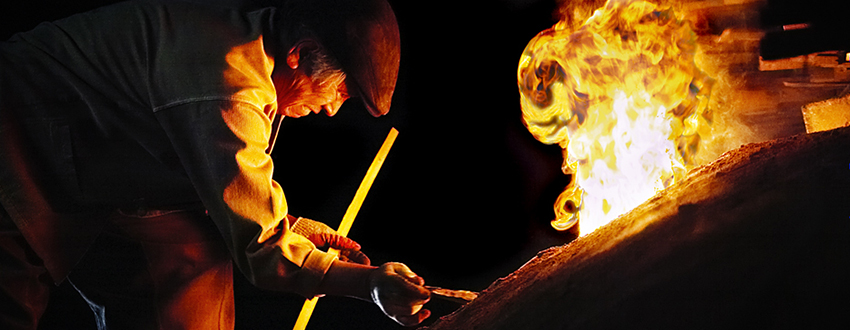 > Pure ware > Pure ware features
> Pure ware > Pure ware features
Characteristics of ‘Pure ware’

Made with clay, salt and wood, without glaze and lye.
The clay is transformed to have mineralogical qualities at the high temperature of over 1300℃, endowing the works with functionality.
Fired in a high temperature, there is an iron-like texture and sound to the work.
According to experiment results, ‘Pure ware’ is at least 40-100 times more breathable than ordinary Onggi ware.
Charged with carbon component, it has the ability to purify air and water, and to deodorize.
It has preservative ability due to the sea salt thrown over the works in the high temperature firing. Food in ‘Pure ware’ can be preserved for longer and remain fresher.
Used to detoxify water in chemotherapy clinics. Enhances chemotherapeutic function through fermentation, and multiplies fermentation organisms and bacteria.
The clay largely affects the functionality of ‘Pure ware’. The clay, collected directly by the Bae family, has no viscosity, and the particles are coarse.
When coarse grains in the clay rub against the hands while being shaped on the wheel, natural marks due to centrifugal force are left on the surface of the works.
The images and patterns with color on the dark blue ‘Pure ware’ are rendered not through glazes, but through the clay which the Bae family collect directly from all over the Korean peninsula. Color is expressed by applying a different colored clay in parts that make up the form, from the parts that make up the image or pattern.
Since ancient times, patterns and decorative design symbolizing class were expressed on the royal ‘Puraedog’. The Ilwol-5 Akdo (image of mountains) drawn on the ‘Puraedog’ symbolized the king, while fish symbolized wealth and turtle, longevity. In addition, the thick band in the decorative pattern called Mojulttee (neck band) or Saseulttee (chain band) symbolized the rank according to the number of the bands on the work.
Condensation is a scientific phenomenon in which liquid evaporates at a certain temperature or after a certain period of time.
Just like dew on grass in the morning, or dew droplets on a glass of cold water, condensation also happens on ‘Pure ware’.
The unglazed surface of the work sometimes feels damp and dew starts to form.
While it’s different for each work, ‘Pure ware’ adapts to its environment, and this phenomenon of condensation gradually disappears.
Dojimi is an ancient method used when making fine wares.
Artifacts of high-quality bowls demonstrate Dojimi marks on the bottom. Today, Dojimi is a fussy process, so it is being omitted altogether.
Clay which is different from the clay that’s used to make the work is formed into round balls and put on the bottom of the work. The work is then fired. This is to make sure that during firing, the fire not only passes through the body of the work but to the bottom of it so that the quality remains the same from the top of the work to its bottom.
The work and Dojimi become stuck together after firing, so Dojimi must be taken off through grinding and polishing.
Therefore, there are marks where Dojimi used to be on the bottom of all ‘Pure ware’.
Works with traces of trickled-down pine tree resin or where fire has passed elevates the artistic value of the work.
Characteristic of a wood kiln made of clay, clay dust can stick on the surface of the work during firing. This becomes smoother with use.
With no use of glaze, several layers of pine tree ash can accumulate on the surface of the work as it fires, completing a rough texture. This becomes smooth with use.
When glaze or lye is used, the joints where handles or ornamentation are attached can be thickly coated and thus concealed. Because ‘Pure ware’ is not coated on its surface, one often misinterprets the joints between handles and ornamentations as signs of cracking and splitting.
After firing in high temperature in a wooden kiln for 5 days, pine tree can burn and become ashes. This coat of ashes remains on the surface of the works for 5 days.
While the color of most ‘Pure ware’ is fundamentally dark blue, works that were placed under a thick coat of tree ashes take a more khaki tone of blue.
The khaki tone of blue color is an evidence that it was fired in a wood kiln with pine tree.
The more apparent the traces of the khaki tone, the higher the work is praised of its artistic quality abroad.
The natural sea salt thrown to the work at the temperature of1300℃ gasifies and fills the kiln, and the degree of the natural sea salt on the work determines the level of luster of the work.
The work is glossy when there is a lot of sea salt, and matte when there is less salt.
When the temperature of the wood kiln is higher than the average firing temperature of 1300℃, the usual dark blue color of ‘Pure ware’ changes to colors that are rare in ‘Pure ware’ (such as gold, silver, metal purple, cobalt blue, pink, brown, etc.)